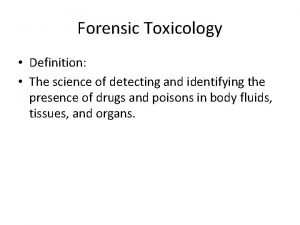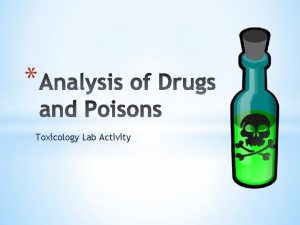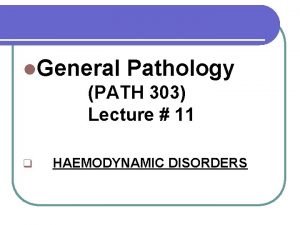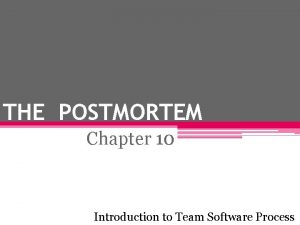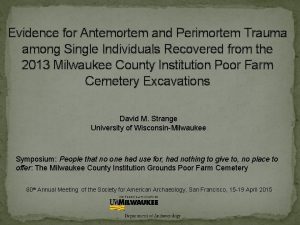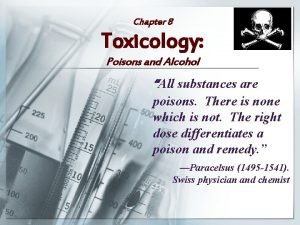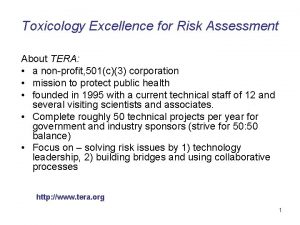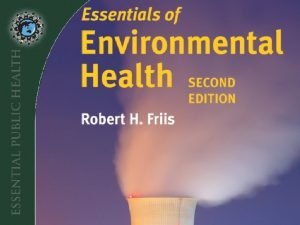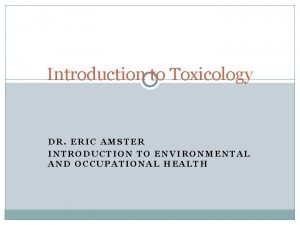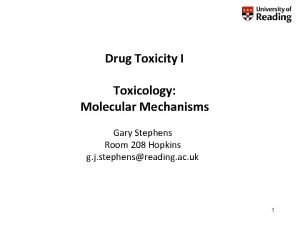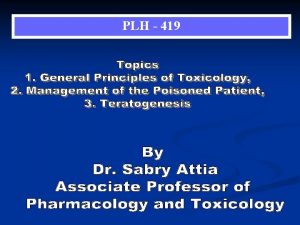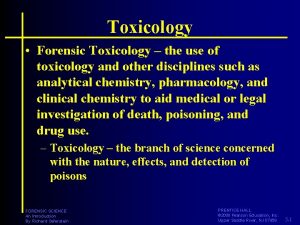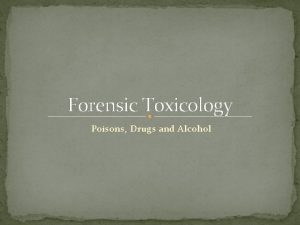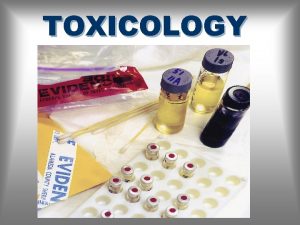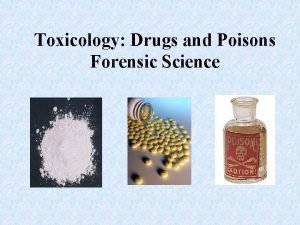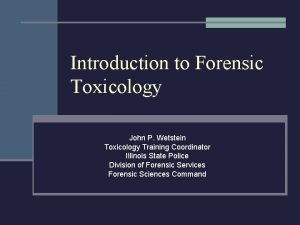POSTMORTEM FORENSIC TOXICOLOGY Outline Definitions and purpose of



































- Slides: 35

POSTMORTEM FORENSIC TOXICOLOGY

Outline � Definitions and purpose of postmortem tox � Samples of forensic interest � Pitfalls in postmortem toxicology � Interpretation of results

Postmortem Forensic Toxicology � The analysis of drugs or poisons specimens collected during an autopsy

What Can The Determine? � the presence or absence of a drug or poison in a submitted sample � the amount of drug or poison that is present in the submitted sample

Some Examples Types of cases: � Suspected drug intoxication cases � Fire deaths � Homicides � Driver and pilot fatalities � Therapeutic drug monitoring � Sudden infant death (SIDS)

SAMPLES OF FORENSIC INTEREST

Issues in Specimen Collection �Selection sites: �Multiple, varied sites of collection �Collection �Appropriate method of collection �Adequate volumes for analysis �Storage and handling Important to ensure results are accurate and interpretations are sound

Typical autopsy specimens � Blood � Urine � Stomach contents � Bile � Liver � Hair � Vitreous the lens. humor: the transparent jellylike tissue filling the eyeball behind

Blood � Antemortem ideal blood sample � Postmortem blood is not truly “blood” � Anatomical site of collection at autopsy should be noted

Subclavian Heart Central sites Heart Peripheral sites Femoral Iliac Subclavian Femoral Other sites Head blood Hematoma blood

Hematoma � Hematoma: a solid swelling of clotted blood in the tissues � Protected � Analysis from metabolism will indicate what drugs were present in the blood at the time of the hematoma was formed

Hematoma case example A 26 year old man was found dead at the bottom of a staircase. Death was due to physical injuries. � Question as to alcohol use prior to fall down stairs � �No urine available at autopsy �Alcohol not detected in femoral blood �Alcohol in hematoma blood 150 mg/100 m. L The deceased had been drinking prior to receiving the head trauma. � The deceased had survived for several hours after the injury. �

Hematoma � Caution: There may be a delay between the incident which resulted in hematoma and the actual formation of the hematoma � Therefore, this alcohol concentration does not necessarily indicate the BAC at the time of the fall down the stairs.

Urine � Produced by the kidneys � Blood filtered by the kidneys � Stored in the bladder until voided the presence of a drug in the urine of an individual indicates that some time prior to death the drug or poison was present in the blood of the individual

Stomach contents Visual examination may reveal tablets � Drugs that have been orally ingested may be detected in stomach contents � Caution: drugs administered by other routes may also diffuse into stomach contents from the blood � Useful for directing further analysis �

Case Example �A 26 year old woman is found dead in bed � Numerous medications in her home: �Amitriptyline, Oxycodone, Morphine, Paroxetine, Diphenhydramine, Pseudoephedrine, Phenobarbital, Codeine, Temazepam, Diazepam � Only 3 m. L of blood collected at autopsy � Analysis of stomach contents: �Amitriptyline: detected �Nortriptyline: detected

Liver � Drug metabolism occurs in the liver � Both parent compounds (main drug) and metabolites (what the drug breaks down to) may be present in higher concentrations in the liver than in the blood ease of detection � Limitation is that drugs are not uniformly distributed throughout the liver confounds interpretation

Bile � Digestive secretion � Continuously produced by the liver � Stored in the gallbladder � Qualitative - the presence of a drug in the bile of an individual indicates that sometime prior to death, the individual was exposed to the drug

Vitreous humor � Fluid that occupies the space between the lens and the retina of the eye. � Useful in cases where decomposition is advanced, body is exhumed or in fire deaths � Limitation is blood: vitreous ratio may not be known

Hair � Recent specimen of interest � Metabolism does not occur in hair � Can provide a historical record of drug or poison exposure � Pros and cons of hair analysis still being uncovered racial variability?

Case Example Poklis, A. 2002. Abstract SOFT, Dearborn, Michigan. � 30 year old woman, previously in good health � Nausea, vomiting, diarrhea, rash, fever � Weakness in hands and feet Guillian Barre? � Hospitalized with hypotension, seizures � Misplaced laboratory result Arsenic! � Sequential hair analysis for arsenic showed chronic arsenic poisoning over 8 month period

Non-biological submissions � Used to direct analysis of biologicals (toxins or drug obtained) � May indicate the nature of substances that may have been ingested, inhaled or injected � Examples: �Containers found at the scene �Syringes �Unidentified tablets or liquids

Samples taken after embalming � Methanol is a typical component of embalming fluid � Most drugs are soluble in methanol � Embalming process will essentially “wash” the vasculature and tissues

Case Example A 72 year old woman, given meperidine to control pain following surgery, later died in hospital. The woman was in poor health and it is possible that death was due to natural causes. However, coroner requests toxicology to rule out inappropriate meperidine levels. BUT: �Body had been embalmed �Liver and spleen submitted

STORAGE AND HANDLING

Storage and Handling � Not feasible to analyze specimens immediately � Sample should be in well-sealed container � Sample containers must be sterile � Use of preservatives and anti-coagulants

Storage of Samples � Preservative �Sodium fluoride � Anti-coagulants �Sodium citrate �Potassium oxalate �EDTA �Heparin �Not imperative for postmortem blood samples

PITFALLS IN POSTMORTEM FORENSIC TOXICOLOGY

Decomposition � Fewer samples available for collection � Quality of samples is diminished � Putrefaction produces alcohols �Ethanol �Isopropanol �Acetaldehyde �n-propanol

Volume of distribution �Volume of distribution is the amount of drug in the whole body (compared to the amount of drug in the blood) �If a drug has a large volume of distribution, it is stored in other fluids and tissues in the body

Example: Digoxin p. 60, Principles of Forensic Toxicology �A 33 year old white female is admitted to hospital after taking 60 digoxin tablets � An antemortem blood sample collected 1 hour prior to her death indicates a blood digoxin level of 18 ng/m. L � Heart blood digoxin concentration obtained at autopsy is 36 ng/m. L

Example: Digoxin � Postmortem increase in blood digoxin concentrations is suspected to be due to the release of the drug from the myocardium (heart)

Postmortem redistribution � Coping with the problem of postmortem redistribution: �Analysis of both central blood and peripheral blood in cases where postmortem redistribution may be a factor �Compilation of tables to determine average and range of postmortem redistribution factors for drugs

Incomplete Distribution � Site dependent differences in drug levels due to differential distribution of drugs at death � Has been noted in rapid iv drug deaths � Example: �Intravenous injection of morphine between the toes �Fatal amount of drug reaches the brain �Full distribution of the morphine throughout the body has not occurred �Femoral concentration > Heart concentration

The end
 Leone lattes contribution to forensic science
Leone lattes contribution to forensic science Define forensic toxicology
Define forensic toxicology A breath test reflects the alcohol concentration where
A breath test reflects the alcohol concentration where Definition of forensic toxicology
Definition of forensic toxicology Forensic toxicology lab activity
Forensic toxicology lab activity Forensic toxicology vocabulary
Forensic toxicology vocabulary Difference between antemortem clot and postmortem clot
Difference between antemortem clot and postmortem clot Postmortem clot
Postmortem clot Postmortem signs
Postmortem signs Late post mortem changes
Late post mortem changes Postmortem in software engineering
Postmortem in software engineering Perimortem trauma
Perimortem trauma Gred spm 2015
Gred spm 2015 Mark bartosik
Mark bartosik Pathologist and anthropologist
Pathologist and anthropologist Forensic psychiatry vs forensic psychology
Forensic psychiatry vs forensic psychology Bread sentence
Bread sentence Chapter 8 toxicology poisons and alcohol
Chapter 8 toxicology poisons and alcohol Toxicology types
Toxicology types Toxicology and applied pharmacology
Toxicology and applied pharmacology Annual review of pharmacology and toxicology
Annual review of pharmacology and toxicology Food safety and toxicology
Food safety and toxicology Drug identification and toxicology
Drug identification and toxicology What is toxicology
What is toxicology Tera toxicology
Tera toxicology Define environmental toxicology
Define environmental toxicology Toxicology management
Toxicology management Washington state patrol toxicology lab
Washington state patrol toxicology lab Toxicology definition
Toxicology definition North carolina medical examiner
North carolina medical examiner Toxicology
Toxicology Examples of toxicology
Examples of toxicology Toxicology
Toxicology Toxicology
Toxicology Toxicology defination
Toxicology defination Which is more toxic
Which is more toxic



